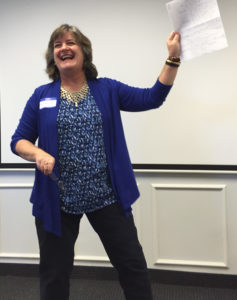Freelance Austin kicked off the New Year with a January meeting full of helpful  advice on how to keep a clear business focus. Solution: Write a ONE PAGE business plan. In her laugh-out-loud presentation, long-time WCA mentor Sheila Scarborough took the angst out of developing a business plan by proposing freelancers stick with a simple solution.
advice on how to keep a clear business focus. Solution: Write a ONE PAGE business plan. In her laugh-out-loud presentation, long-time WCA mentor Sheila Scarborough took the angst out of developing a business plan by proposing freelancers stick with a simple solution.
The task can seem overwhelming if you think of a business plan as a complicated multi-paged document with detailed financial information, market analyses and management philosophy. But according to Sheila, what helped her business the most was a simple, one-page plan. This short plan provided her business with three important things: foundation, focus and direction.
Sheila now helps run Tourism Currents, along with Leslie McClellan and Becky McCray. The business offers online and in-person social media training for the tourism and hospitality industry. Sheila is also working on a book called The Elastic Waist Entrepreneur. But before that, Sheila had no business experience or exposure at all. She told us about her background growing up in a Navy family, pursuing a liberal arts degree and then becoming a career Navy officer herself. Not only was she lacking a business background, she is also the type of easily distracted multi-tasker who might have 48 tabs on her computer open at one time (I can relate, since I am currently flipping through 23). “The one-page business plan was achievable and helped me focus by keeping the monkeys out of my head,” Sheila explained.
Sheila referred to Art of the Start: The Time Tested, Battle-Hardened Guide for Anyone Starting Anything by Guy Kawasaki. The book covers all aspects of starting a business, including writing a business plan. Kawasaki recommends putting most of your focus on the executive summary of your plan, since realistically, that’s the only part most people will read. While the detail of the plan may not be as visible as the executive summary to others, it is still worthwhile. For Sheila it was the process of writing the detail that helped her gain focus and clarity about her business.
In fact, Sheila’s business plan (which you can download here) looks like a process, even in its layout. Instead of the typical written plan in list form, Sheila uses a diagram to explain the information in her plan. This way she can better visualize how the aspects of the plan connect. Sheila challenged herself to fit the words explaining each part of the plan into the boxes on the diagram she was working with, forcing her to be concise with her wording.
Sheila also mentioned The $100 Startup by Chris Guillebeau. This is yet another resource that encourages keeping things short. He recommends writing a 140-character mission statement for your business plan, keeping it as concise as a Twitter post. Any longer and you lose people’s attention. One meeting participant gave the exercise a whirl, explaining her business mission succinctly, “I provide strategic planning facilitation for associations so that they can focus on their strengths and their mission.”
On Guillebeau’s website for his book 100Startup.com you can find easy templates for planning a startup, including a template for a one-page business plan.
In the meeting, Sheila covered the important information to include in the Overview section of the plan.
Overview
What will you sell? (your product/service)
Sheila recommended making sure your customers fully understand “the awesomeness” of your product, and stressed to always bring it back to how it benefits your customer. They need to feel a sense of urgency to buy your product or service.
Who will buy it? (your target market)
Be very specific when targeting a market. Don’t try to be everything to everyone. “While your market might be dentists, it would be much better to target dentists with a 3-person office in Texas.”
How will your business idea help people?
Be able to define what exact problem your business solves.
One of the most important aspects of a plan that some people forget is the Core Values of the business. What is your reason for doing this business besides making money? This aspect of your business should infuse all your efforts as part of your cultural architecture.
Finally, Sheila discussed that you need to explain who YOU are in your business plan. What are your strengths, and how do they tie back to your core values? As an aside, defining your strengths will also help you define your weaknesses. These are the areas you should consider outsourcing.
There are numerous local resources that can help you with your business plan. Sheila mentioned SCORE (the Service Core of Retired Executives) and SBDC (Small Business Development Counsel). There are also many helpful handouts and links on the Freelance Austin site.
But all other resources aside, I have never had more fun talking about a business plan than in this meeting with Sheila. If you don’t believe me, you can see her personality shine through in her use of “BHAG” in the plan, which stands for “Big Hairy Audacious Goal,” a term coined in her military background. Business plans just don’t get more interesting than that!
- The One-Page Business Plan: January Meeting Recap - January 29, 2016
